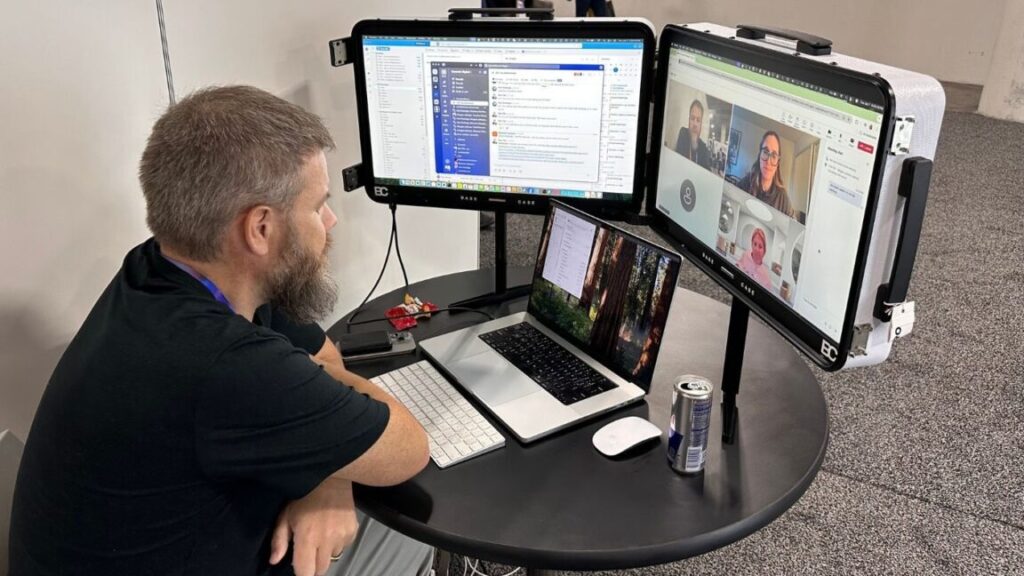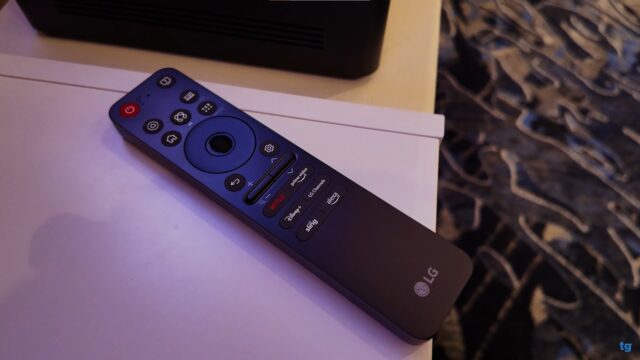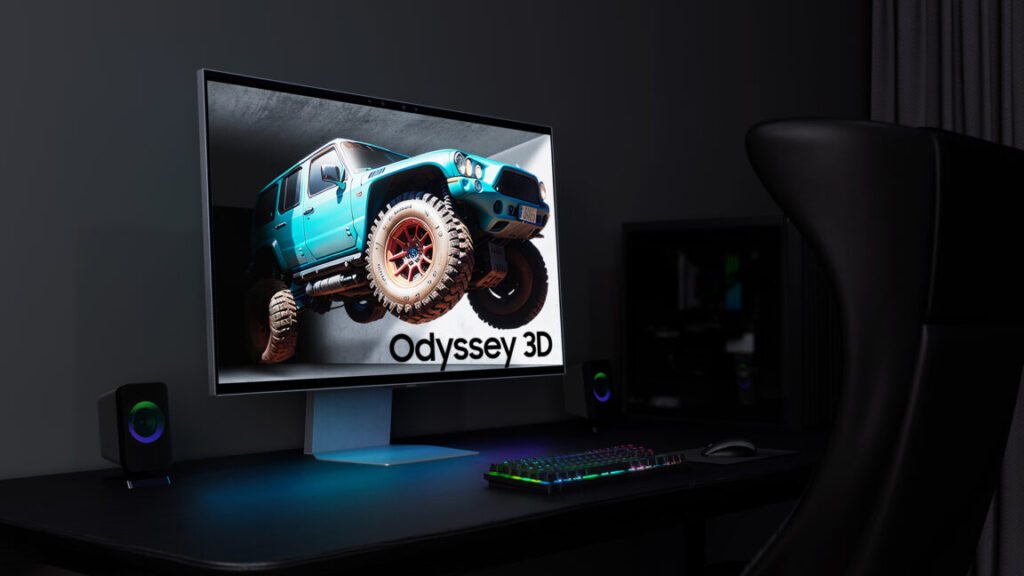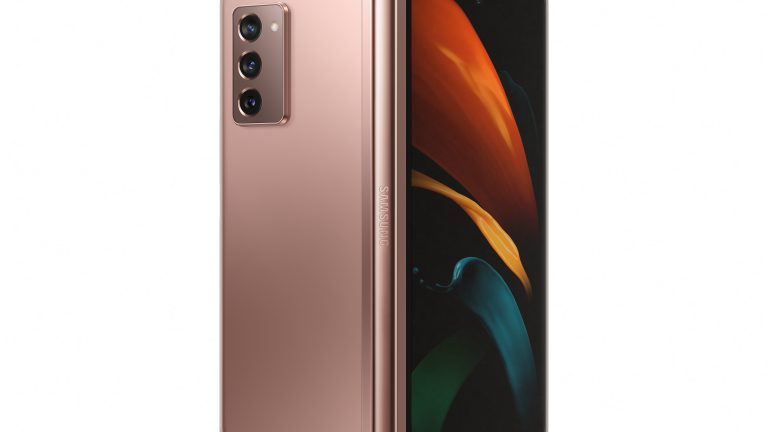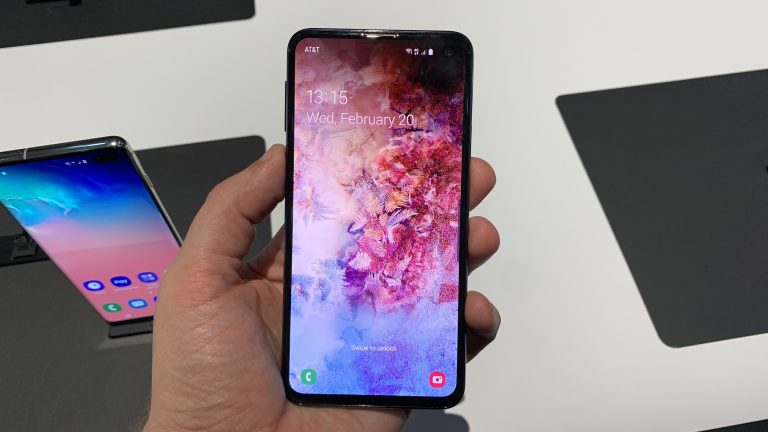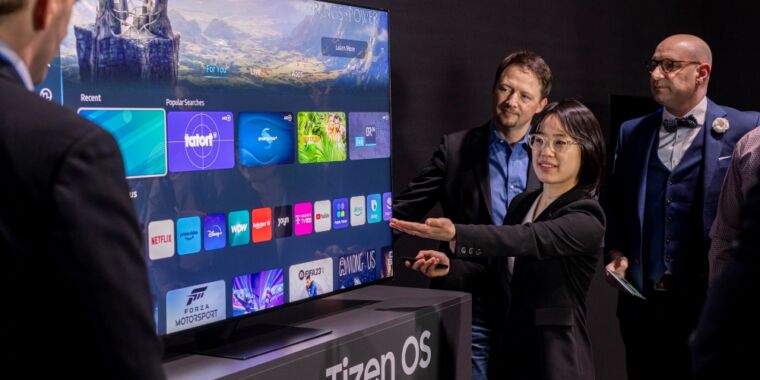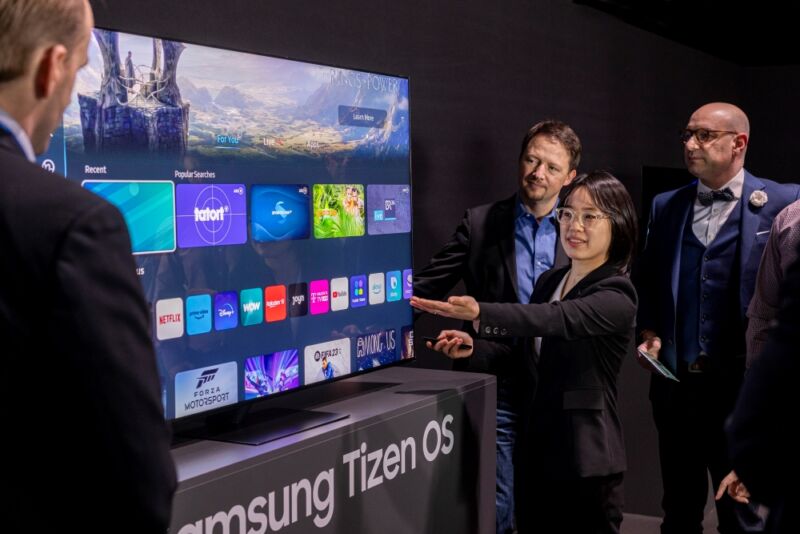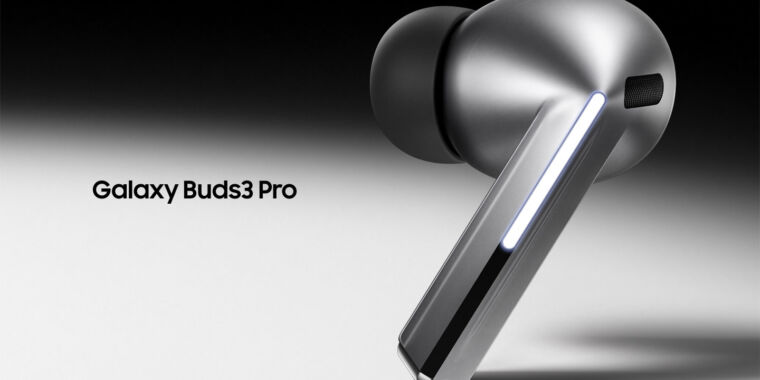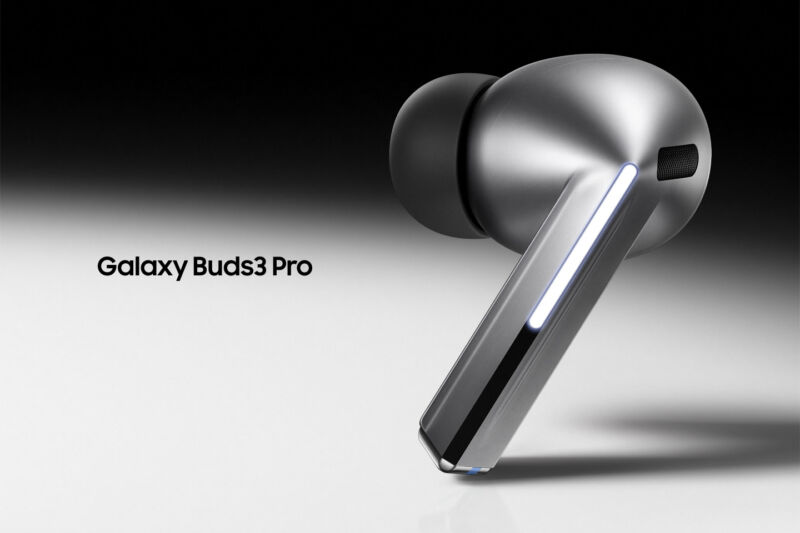The 8 most interesting PC monitors from CES 2025
Plenty of computer monitors made debuts at the Consumer Electronics Show (CES) in Las Vegas this year, but many of the updates at this year’s event were pretty minor. Many could have easily been a part of 2024’s show.
But some brought new and interesting features to the table for 2025—in this article, we’ll tell you all about them.
LG’s 6K monitor
Pixel addicts are always right at home at CES, and the most interesting high-resolution computer monitor to come out of this year’s show is the LG UltraFine 6K Monitor (model 32U990A).
People seeking more than 3840×2160 resolution have limited options, and they’re all rather expensive (looking at you, Apple Pro Display XDR). LG’s 6K monitor means there’s another option for professionals needing extra pixels for things like developing, engineering, and creative work. And LG’s 6144×3456, 32-inch display has extra oomph thanks to something no other 6K monitor has: Thunderbolt 5.

This is the only image LG provided for the monitor. Credit: LG
LG hasn’t confirmed the refresh rate of its 6K monitor, so we don’t know how much bandwidth it needs. But it’s possible that pairing the UltraFine with a Thunderbolt 5 PC could trigger Bandwidth Boost, a Thunderbolt 5 feature that automatically increases bandwidth from 80Gbps to 120Gbps. For comparison, Thunderbolt 4 maxes out at 40Gbps. Thunderbolt 5 also requires 140 W power delivery and maxes out at 240 W. That’s a notable bump from Thunderbolt 4’s 100–140 W.
Considering that Apple’s only 6K monitor has Thunderbolt 3, Thunderbolt 5 is a differentiator. With this capability, the LG UltraFine is ironically better equipped in this regard for use with the new MacBook Pros and Mac Mini (which all have Thunderbolt 5) compared to Apple’s own monitors. LG may be aware of this, as the 32U990A’s aesthetic could be considered very Apple-like.
Inside the 32U990A’s silver chassis is a Nano IPS panel. In recent years, LG has advertised its Nano IPS panels as having “nanometer-sized particles” applied to their LED backlight to absorb “excess, unnecessary light wavelengths” for “richer color expression.” LG’s 6K monitor claims to cover 98 percent of DCI-P3 and 99.5 percent of Adobe RGB. IPS Black monitors, meanwhile, have higher contrast ratios (up to 3,000:1) than standard IPS panels. However, LG has released Nano IPS monitors with 2,000:1 contrast, the same contrast ratio as Dell’s 6K, IPS Black monitor.
LG hasn’t shared other details, like price or a release date. But the monitor may cost more than Dell’s Thunderbolt 4-equipped monitor, which is currently $2,480.
Brelyon’s multi-depth monitor

Someone from CNET using the Ultra Reality Extend. Credit: CNET/YouTube
Brelyon is headquartered in San Mateo, California, and was founded by scientists and executives from MIT, IMAX, UCF, and DARPA. It’s been selling display technology for commercial and defense applications since 2022. At CES, the company unveiled the Ultra Reality Extend, describing it as an “immersive display line that renders virtual images in multiple depths.”
“As the first commercial multi-focal monitor, the Extend model offers multi-depth programmability for information overlay, allowing users to see images from 0.7 m to as far as 2.5 m of depth virtually rendered behind the monitor; organizing various data streams at different depth layers, or triggering focal cues to induce an ultra immersive experience akin to looking out through a window,” Brelyon’s announcement said.
Brelyon says the monitor runs 4K at 60 Hz with 1 bit of monocular depth for an 8K effect. The monitor includes “OLED-based curved 2D virtual images, with the largest stretching to 122 inches and extending 2.5 meters deep, viewable through a 30-inch frame,” according to the firm’s announcement. The closer you sit, the greater the field of view you get.
The Extend leverages “new GPU capabilities to process light and video signals inside our display platforms,” Brelyon CEO Barmak Heshmat said in a statement this week. He added: “We are thinking beyond headsets and glasses, where we can leverage GPU capabilities to do real-time driving of higher-bandwidth display interfaces.”

Brelyon says this was captured from the Extend, with its camera lens focus changing from 70 cm to 2,500 cm. Credit: Brelyon
Advancements in AI-based video processing, as well as other software advancements and hardware improvements, purportedly enable the Extend to upscale lower-dimension streams to multiple, higher-dimension ones. Brelyon describes its product as a “generative display system” that uses AI computation and optics to assign different depth values to content in real time for rendering images and information overlays.
The idea of a virtual monitor that surpasses the field of view of typical desktop monitors while allowing users to see the real world isn’t new. Tech firms (including many at CES) usually try to accomplish this through AR glasses. But head-mounted displays still struggle with problems like heat, weight, computing resources, battery, and aesthetics.
Brelyon’s monitor seemingly demoed well at CES. Sam Rutherford, a senior writer at Engadget, watched a clip from the Marvel’s Spider-Man video game on the Extend and said that “trees and light poles whipping past in my face felt so real I started to flinch subconsciously.” He added that the monitor separated “different layers of the content to make snow in the foreground look blurry as it whipped across the screen, while characters in the distance” still looked sharp.
The monitor costs $5,000 to $8,000 depending on how you’ll use it and whether you have other business with Brelyon, per Engadget, and CES is one of the few places where people could actually see the display in action.
Samsung’s 3D monitor

Samsung’s depiction of the 3D effect of its 3D PC monitor. Credit: Samsung
It’s 2025, and tech companies are still trying to convince people to bring a 3D display into their homes. This week, Samsung took its first swing since 2009 at 3D screens with the Odyssey 3D monitor.
In lieu of 3D glasses. the Odyssey 3D achieves its 3D effect with a lenticular lens “attached to the front of the panel and its front stereo camera,” Samsung says, as well eye tracking and view mapping. Differing from other recent 3D monitors, the Odyssey 3D claims to be able to make 2D content look three-dimensional even if that content doesn’t officially support 3D.
You can find more information in our initial coverage of Samsung’s Odyssey 3D, but don’t bet on finding 3D monitors in many people’s homes soon. The technology for quality 3D displays that work without glasses has been around for years but still has never taken off.
Dell’s OLED productivity monitor
With improvements in burn-in, availability, and brightness, finding OLED monitors today is much easier than it was two years ago. But a lot of the OLED monitors released recently target gamers with features like high refresh rates, ultrawide panels, and RGB. These features are unneeded or unwanted by non-gamers but contribute to OLED monitors’ already high pricing. Numerous smaller OLED monitors were announced at CES, with 27-inch, 4K models being a popular addition. Most of them are still high-refresh gaming monitors, though.
The Dell 32-inch QD-OLED, on the other hand, targets “play, school, and work,” Dell’s announcement says. And its naming (based on a new naming convention Dell announced this week that kills XPS and other longstanding branding) signals that this is a mid-tier monitor from Dell’s entry-level lineup.

OLED for normies. Credit: Dell
The monitor’s specs, which include a 120 Hz refresh rate, AMD FreeSync Premium, and USB-C power delivery at up to 90 W, make it a good fit for pairing with many mainstream laptops.
Dell also says this is the first QD-OLED with spatial audio, which uses head tracking to alter audio coming from the monitor’s five 5 W speakers. This is a feature we’ve seen before, but not on an OLED monitor.
For professionals and/or Mac users that prefer the sleek looks, reputation, higher power delivery and I/O hubs associated with Dell’s popular UltraSharp line, Dell made two more notable announcements at CES: an UltraSharp 32 4K Thunderbolt Hub Monitor (U3225QE) coming out in February 25 for $950 and an UltraSharp 27 4K Thunderbolt Hub Monitor (U2725QE) coming out that same day for $700.
The suitcase monitors
Before we get into the Base Case, please note that this product has no release date because its creators plan to go to market via crowdfunding. Base Case says it will launch its Indiegogo campaign next month, but even then, we don’t know if the project will be funded, if any final product will work as advertised, or if customers will receive orders in a timely fashion. Still, this is one of the most unusual monitors at CES, and it’s worth discussing.
The Base Case is shaped like a 24x14x16.5-inch rolling suitcase, but when you open it up, you’ll find two 24-inch monitors for connecting to a laptop. Each screen reportedly has a 1920×1080 resolution, a 75 Hz refresh rate, and a max brightness claim of 350 nits. Base Case is also advertising PC and Mac support (through DisplayLink), as well as HDMI, USB-C, USB-A, Thunderbolt, and Ethernet ports. Telescoping legs allow the case to rise 10 inches so the display can sit closer to eye level.
Ultimately, the Base Case would see owners lug around a 20-pound product for the ability to quickly create a dual-monitor setup equipped with a healthy amount of I/O. Tom’s Guide demoed a prototype at CES and reported that the monitors took “seconds to set up.”
In case you’re worried that the Base Case prioritizes displays over storage, note that its makers plan on adding a front pocket to the suitcase that can fit a laptop. The pocket wasn’t on the prototype Tom’s Guide saw, though.
Again, this is far from a finalized product, but Base Case has alluded to a $2,400 starting price. For comparison to other briefcase-locked displays—and yes, doing this is possible—LG’s StanbyME Go (27LX5QKNA) tablet in a briefcase currently has a $1,200 MSRP.
Corsair’s PC-mountable touchscreen

A promotional image of the touchscreen.
If the Base Case is on the heftier side of portable monitors, Corsair’s Xeneon Edge is certainly on the minute side. The 14.5-inch LCD touchscreen isn’t meant to be a primary display, though. Corsair built it as a secondary screen for providing quick information, like the song your computer is playing, the weather, the time, and calendar events. You could also use the 2560×720 pixels to display system information, like component usage and temperatures.
Corsair says its iCue software will be able to provide system information on the Xeneon, but because the Xeneon Edge works like a regular monitor, you could (and likely would prefer to) use your own methods. Still, the Xeneon Edge stands out from other small, touchscreen PC monitors with its clean UI that can succinctly communicate a lot of information on the tiny display at once.
Specs-wise, this is a 60 Hz IPS panel with 5-point capacitive touch. Corsair says the monitor can hit 350 nits of brightness.
You can connect the Xeneon Edge to a computer via USB-C (DisplayPort Alt mode) or HDMI. There are also screw holes, so PC builders could install it via a 360 mm radiator mounting point inside their PC case.
Alternatively, Corsair recommends attaching the touchscreen to the outside of a PC case through the monitor’s 14 integrated magnets. Corsair said in a blog post that the “magnets are underneath the plastic casing so the metal surface you stick it to won’t get scratched.” Or, in traditional portable monitor style, the Xeneon Edge could also just sit on a desk with its included stand.
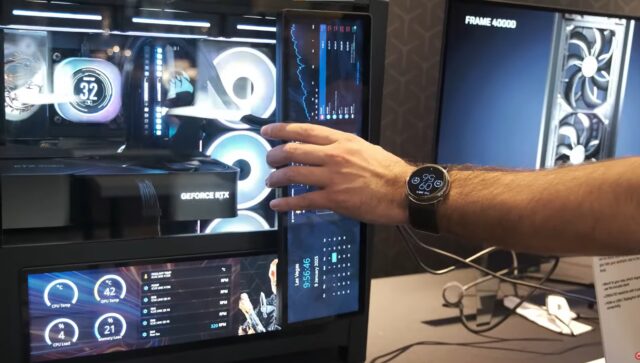
Corsair demos different ways the screen could attach to a case. Credit: TechPowerUp/YouTube
Corsair plans to release the Xeneon Edge in Q2. Expected pricing is “around $249,” Tom’s Hardware reported.
MSI’s side panel display panel
Why attach a monitor to your PC case when you can turn your PC case into a monitor instead?
MSI says that the touchscreen embedded into this year’s MEG Vision X AI 2nd gaming desktop’s side panel can work like a regular computer monitor. Similar to Corsair’s monitor, the MSI’s display has a corresponding app that can show system information and other customizations, which you can toggle with controls on the front of the case, PCMag reported.
MSI used an IPS panel with 1920×1080 resolution for the display, which also has an integrated mic and speaker. MSI says “electric vehicle control centers” inspired the design. We’ve seen similar PC cases, like iBuyPower’s more translucent side panel display and the touchscreen on Hyte’s pentagonal PC case, before. But MSI is bringing the design to a more mainstream form factor by including it in a prebuilt desktop, potentially opening the door for future touchscreen-equipped desktops.
Considering the various locations people place their desktops and the different angles at which they may try to look at this screen, I’m curious about the monitor’s viewing angles and brightness. IPS seems like a good choice since it tends to have strong image quality when viewed from different angles. A video PC Mag shot from the show floor shows images on the monitor appearing visible and lively:
Hands on with MSI’s MEG Vision X AI Desktop: Now, your PC tower’s a monitor, too.
World’s fastest monitor
There’s a competitive air at CES that lends to tech brands trying to one-up each other on spec sheets. Some of the most heated competition concerns monitor refresh rates; for years, we’ve been meeting the new world’s fastest monitor at CES. This year is no different.
The brand behind the monitor is Koorui, a three-year-old Chinese firm whose website currently lists monitors and keyboards. Koorui hasn’t confirmed when it will make its 750 Hz display available, where it will sell it, or what it will cost. That should bring some skepticism about this product actually arriving for purchase in the US. However, Koorui did bring the display to the CES show floor.
The speedy display had a refresh rate test running at CES, and according to several videos we’ve seen from attendees, the monitor appeared to consistently hit the 750 Hz mark.
World’s first 750Hz monitor???
For those keeping track, high-end gaming monitors—namely ones targeting professional gamers—hit 360 Hz in 2020. Koorui’s announcement means max monitor speeds have increased 108.3 percent in four years.
One CES attendee noticed, however, that the monitor wasn’t showing any gameplay. This could be due to the graphical and computing prowess needed to demonstrate the benefits of a 750 Hz monitor. A system capable of 750 frames per second would give people a chance to see if they could detect improved motion resolution but would also be very expensive. It’s also possible that the monitor Koorui had on display wasn’t ready for that level of scrutiny yet.
Like many eSports monitors, the Koorui is 24.5 inches, with a resolution of 1920×1080. Perhaps more interesting than Koorui taking the lead in the perennial race for higher refresh rates is the TN monitor’s claimed color capabilities. TN monitors aren’t as popular as they were years ago, but OEMs still employ them sometimes for speed.
They tend to be less colorful than IPS and VA monitors, though. Most offer sRGB color gamuts instead of covering the larger DCI-P3 color space. Asus’ 540 Hz ROG Swift Pro PG248QP, for example, is a TN monitor claiming 125 percent sRGB coverage. Koorui’s monitor claims to cover 95 percent of DCI-P3, due to the use of a quantum dot film. Again, there’s a lot that prospective shoppers should confirm about this monitor if it becomes available.
For those seeking the fastest monitors with more concrete release plans, several companies announced 600 Hz monitors coming out this year. Acer, for example, has a 600 Hz Nitro XV240 F6 (also a TN monitor) that it plans to release in North America this quarter at a starting price of $600.
The 8 most interesting PC monitors from CES 2025 Read More »
